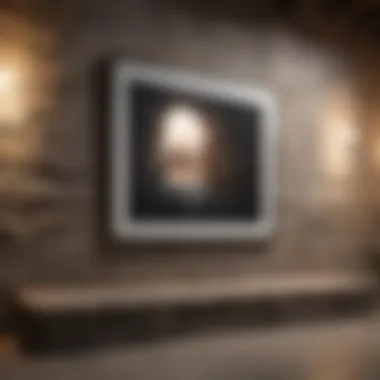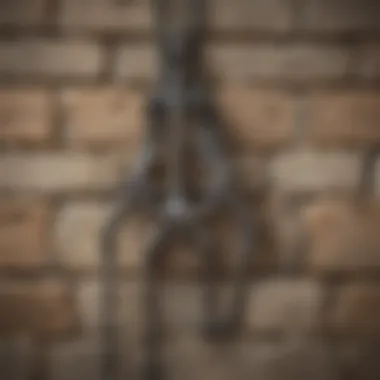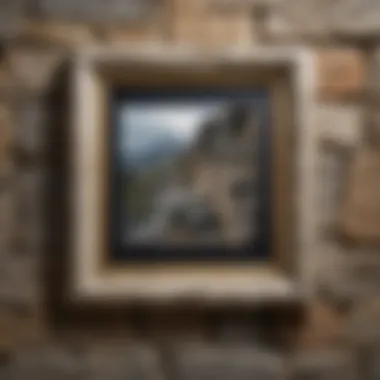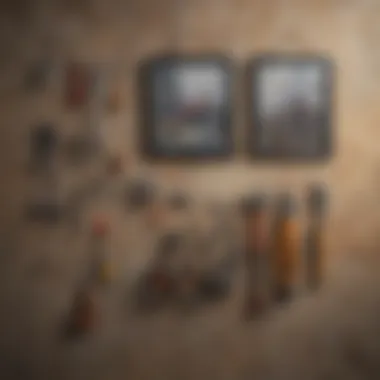Expert Guide to Hanging Pictures on Stone Walls


Intro
Hanging pictures on a stone wall presents unique challenges and opportunities that require careful consideration. Unlike drywall or plaster, stone surfaces are often uneven and rigid, making the process of installation more meticulous. However, the rewards of successfully mounting artwork in such a setting can be significant. Not only does it enhance the aesthetic appeal of the space, but it also allows for a versatile display that complements various interior design themes.
In this guide, we will walk you through the various preparations, tools, and techniques necessary for this task. Understanding how to safely and securely hang pictures on stone walls will enable you to showcase your art collection in an elegant manner, regardless of the type of stone used. From selecting the appropriate hardware to understanding the nuances of different stone types, this article serves as a comprehensive resource for anyone looking to undertake this home improvement project.
Understanding Stone Walls
Understanding stone walls is essential when considering how to hang pictures effectively. Stone walls present unique challenges due to their varied textures, the nature of the materials used, and the structural stability they offer. Knowing these aspects ensures that one can attach frames securely without risking damage to both the artwork and the wall itself.
When assessing stone walls for picture hanging, several factors come into play. First and foremost, the type of stone used can dictate the methods you employ. For instance, some stones are softer and easier to drill into, while others are extremely hard and require specialized tools. Additionally, understanding the aesthetic qualities of stone is crucial. The natural colors and patterns can influence the choice of art and the hanging style, impacting the overall ambiance of your space.
One major benefit of properly understanding stone walls is that it enhances durability. With the right techniques and tools, you can ensure that your artwork is not only displayed beautifully but also remains secure over time. This, in turn, allows you to enjoy your collection without the constant worry of dislodgement or damage.
"The strength of a stone wall lies not only in its construction but also in how we choose to interact with it through design."
Engaging with stone walls also requires thoughtful consideration towards their maintenance. Regular inspections and an understanding of potential issues such as moisture and wear can prolong their life and the life of the art displayed upon them. By creating a clear foundation of knowledge about stone walls, one sets the stage for successful artwork hanging, bringing both practicality and beauty into the home.
Preparation for Hanging Pictures
Preparing to hang pictures on a stone wall is a crucial step that can significantly impact the success of your installation. The process encompasses several components including selecting the right location and accurately measuring positions. Proper preparation not only ensures that your artwork is displayed effectively, but also that it remains secure over time.
Selecting the Right Location
Choosing an appropriate spot for your artwork is essential. Factors to take into account include lighting, height, and proximity to other decor elements. Natural light can enhance colors in artwork, but direct sunlight might fade certain materials over time. Additionally, the height at which you hang the pictures should reflect the viewing experience. Generally, eye level is often recommended for optimal enjoyment.
Also consider the flow of the space. If the wall is a high-traffic area, ensure that the pictures are hung well away from where people walk. This prevents accidental bumps that could lead to damages. Sometimes, a test run using painter’s tape on the wall can help visualize where you want to place your art before making any permanent decisions.
Measuring and Marking Positions
Once the location is decided, measuring is next on the list. This helps avoid any guesswork. Use a tape measure to determine the exact height and width on the stone wall where your picture will go. Mark these points with a pencil or a small piece of painter's tape, which can be removed easily without damaging the wall. Consensus in the design community suggests that the center of the artwork should align with the mid-point of average eye level, about 57 to 60 inches from the floor.
Consider the size of the picture as well. A large artwork may require a significant space, while smaller pieces can be grouped for a gallery-style effect. Take special care in measuring if you plan to hang multiple pieces at the same time to maintain symmetry and balance. Attention to small details like these will contribute to a more cohesive and professional aesthetic.
"Proper preparation lays the groundwork for a successful installation, transforming your space into a gallery-like environment."
By investing time in selecting the right location and measuring accurately, you set the stage for a successful display of your artwork on stone walls. This thoughtful approach is vital in enhancing both the beauty and functionality of your space.
Tools and Materials Required
Proper tools and materials are vital when it comes to hanging pictures on stone walls. A stone wall presents unique challenges compared to other surfaces, making the selection of adequate equipment essential. The right tools not only ensure that the job is done successfully but also affect the longevity and stability of the installation. The tools and materials used can determine the ease of the project and impact the overall aesthetic of the displayed artwork. Understanding what is needed allows for better preparation and minimizes the chances of damage to the wall.
Basic Tools for Installation
A few key tools make the process of hanging pictures on stone walls simpler.


- Drill: A powerful drill is essential. When working with stone, it is crucial to use a hammer drill or a rotary hammer with a masonry bit. This type of drill can penetrate tougher surfaces without losing power.
- Measuring Tape: Accurate measurement is important. A measuring tape helps to determine the best location for hanging and to ensure your artwork is aligned and spaced correctly.
- Level: To achieve a straight installation, a level is necessary. This tool helps in determining if the picture frame is straight on the wall, which is an important consideration for aesthetics.
- Pencil: This simple tool is needed for marking measurements on the wall. However, it is best to use a softer pencil so that marks can be easily removed later.
- Safety Glasses and Gloves: Protection is necessary when using tools, especially when drilling into stone. These items ensure safety against dust and debris.
Using these basic tools simplifies the process, making the installation smoother and more effective.
Types of Fasteners Suitable for Stone Walls
Choosing the right fasteners for stone walls is crucial as they need to support weight and withstand environmental factors. Here are some suitable types:
- Expansion Anchors: These are ideal for stony surfaces. They expand as the screw is tightened, securing the anchor firmly in place.
- Masonry Screws: These screws are designed specifically for stone. They usually have a hardened structure that allows them to bite into the masonry securely.
- Toggle Bolts: When a heavier picture is to be hung, toggle bolts provide excellent support. They spread the load across a wider area, which is beneficial for stone walls.
- Adhesive Hooks: For lightweight art, adhesive hooks can work, but they may not be appropriate for larger frames. It’s good to evaluate what kind of art you're hanging before selecting fasteners.
Each type of fastener has its own advantages, and selection should be based on the weight of the items being hung and the nature of the stone.
Choosing the Right Hanging Hardware
The hanging hardware used plays a significant role in the overall success of installation. Here are key considerations:
- Picture Hanging Kits: Many picture hanging kits come with assorted hardware. Assess the weight of the picture you intend to hang and ensure the kit can support it.
- D-Rings and Sawtooth Hangers: Both types of hangers are suitable for most frames. D-rings are sturdy and ideal for heavier frames, while sawtooth hangers are convenient for lighter artwork.
- Wall Rails: For multiple artworks, a wall rail system allows for flexibility. It makes switching and rearranging artwork easier without additional drilling.
- Adhesive Strips: For lightweight artwork, adhesive strips provide a no-damage solution. However, keep in mind they may not provide the long-term stability needed for heavier pieces.
Choosing the right hanging hardware ensures that artwork remains securely displayed while maintaining the integrity of the stone wall.
Proper selection of tools, fasteners, and hanging hardware can greatly enhance the durability and visual appeal of the displayed art on stone walls.
Techniques for Hanging Pictures
Hanging pictures on stone walls requires specific techniques due to the hard and uneven surfaces. These methods not only ensure the aesthetic appeal of your display but also guarantee its longevity. Understanding the right techniques allows homeowners to securely mount artwork while avoiding damage to both the art piece and the wall itself.
Using Wall Anchors
Wall anchors are essential when hanging heavier pieces on a stone wall. They provide a stronger hold compared to traditional nails or screws. Installing wall anchors involves drilling a hole into the stone at the desired location before inserting the anchor. The anchor expands inside the hole, creating a grasp on the wall. For optimal results, choosing the right size of wall anchor is critical. Consider the weight of the artwork and select anchors accordingly. Additionally, distribution of weight across multiple anchors can enhance stability and prevent accidents.
Drilling into Stone
Drilling into stone is a skill that requires proper tools and techniques. A hammer drill with a masonry bit is necessary for creating holes in stone surfaces. Before starting, ensure to mark the exact spot where you want to drill. Applying steady pressure while drilling is important to avoid damaging both the bit and the stone itself. It's also advisable to check for any hidden utilities before drilling. Regularly clearing dust from the hole helps achieve a clean finish and makes inserting anchors easier. This method is reliable for heavy items and artworks that require strong support.
Adhesive Options for Lightweight Art
For lightweight pictures, adhesive solutions can be an effective alternative to drilling and using anchors. Several adhesives designed specifically for stone surfaces are available. These include industrial-strength mounting adhesives and removable strips. Such adhesives offer the convenience of quick installation while ensuring that no permanent damage occurs to the wall. When using these options, it is crucial to follow the manufacturer's instructions to achieve the best results. Ensure the surface is clean and dry before applying the adhesive to enhance bond strength.
"Choosing the right technique is vital for ensuring that your artistic displays are not only visually appealing but also securely mounted to withstand time and environmental factors."
Mastering these techniques is essential for anyone looking to display art on stone walls. Whether you opt for wall anchors, drilling, or adhesives, each method comes with its own set of benefits and considerations. Taking the time to understand these methods will significantly improve the outcome of your picture hanging project.
Displaying Artwork Securely
Displaying artwork on a stone wall presents unique challenges that require careful consideration. The permanence and texture of stone can make conventional hanging methods inadequate. Therefore, focusing on secure display becomes not just a necessity but a significant aspect of the overall process. Ensuring that artwork remains safely mounted preserves its aesthetic impact while safeguarding against potential hazards, such as falling pieces and damage to the wall. Additionally, the right techniques will promote a longer life for both the artwork and the wall itself.


Safety Considerations
When contemplating how to secure pieces of art on stone walls, safety is paramount. This not only includes finding the correct hardware but also understanding the installed piece's context. Here are key considerations:
- Choosing the Right Fasteners: Using correct fasteners, like wall anchors designed for stone, enhances stability.
- Assessing Weight Limits: Evaluate the weight of your artwork. Heavier pieces require stronger supports to avoid accidents.
- Checking Wall Integrity: Before attaching anything to the stone, ensure there are no cracks or damage that could compromise security.
It is advisable to periodically inspect the fasteners to ensure they remain in good condition. Promptly addressing any signs of wear can prevent larger safety issues down the line.
Weight Distribution and Balance
Effective weight distribution and balance are crucial components to secure a display. Poorly balanced artwork can lead to an unaesthetic appearance and can even be hazardous. Some tips for achieving the right balance include:
- Center of Gravity: Place heavier items lower to maintain a steady base. This helps stabilize the overall arrangement.
- Grouping Similar Weights: When creating a gallery wall, consider grouping artwork by weight. This creates visual harmony and supports structural stability.
- Use of Shelving: Incorporating shelves can alleviate some weight from the wall itself, allowing for flexible arrangements.
Balancing pieces effectively not only enhances visual appeal but also significantly contributes to overall security.
Maintaining a focus on safety and balance ensures art is not merely a decoration but an integral part of the living space, harmonizing beauty and functionality.
Common Challenges and Solutions
Hanging pictures on a stone wall presents unique difficulties not found in standard wall materials. There are factors such as surface irregularities and environmental conditions that can affect the installation process. Understanding these challenges aids in effective planning and successful integration of artworks into the stone environment. Solutions are not merely about overcoming obstacles but also about optimizing the aesthetic and functional aspects of the space.
Uneven Surfaces
One of the primary challenges when working with stone walls is dealing with their uneven surfaces. Unlike drywall, which is typically flat, stone walls can have protrusions, indentations, and varying textures. This irregularity can make securing pictures difficult.
To address this:
- Assess the Wall: Before hanging, examine the entire area where you intend to place the artwork. Identify any major bumps or depressions.
- Use Spacers: If a picture frame has a flush back, consider using spacers to accommodate any gaps between the wall and the picture. This can create a more level appearance.
- Choose Appropriate Hardware: Wall anchors and brackets can adjust to the wall's irregularities, allowing for better weight distribution. Look for heavy-duty options designed specifically for masonry.
The unevenness also can contribute to a lack of visual appeal if not properly considered. Balancing the look of various artworks on such surfaces requires careful consideration of their sizes and shapes. Arranging frames with similar dimensions or aesthetics can mitigate this challenge.
Dealing with Moisture
Moisture is another significant concern when hanging pictures on stone walls, especially in areas with high humidity or in basements. Stone is porous, and any trapped moisture can harm both the stone and the artwork over time. Ensuring good protection and installation techniques can help prevent damage.
Here are steps to consider:
- Check Moisture Levels: Use a moisture meter to evaluate the wall conditions prior to installation. If moisture levels are high, consider waiting until conditions improve.
- Select the Right Location: Avoid hanging artwork in areas prone to condensation, such as near windows or pipes. This step minimizes potential damage.
- Use Resistant Materials: Opt for moisture-resistant frames and artwork that can withstand damp environments. Acrylic can be a good choice, as it’s less vulnerable to damage compared to glass.
"Being proactive in assessing these common challenges can save both time and resources during installation, resulting in a more secure and aesthetically pleasing outcome."
Addressing uneven surfaces and moisture concerns effectively enhances both the stability of the installations and the longevity of the artwork. It prepares the surface for successfully blending art with the rugged charm of stone walls.
Creative Approaches to Hanging


Hanging pictures on a stone wall can feel restrictive due to the nature of the surface. Still, embracing creative approaches can elevate the aesthetic and functionality of your space. By thinking outside the box, you can transform blank walls into compelling displays of art and memories. Creative approaches allow for personal expression while ensuring that installations remain practical and secure.
Gallery Walls on Stone
Creating a gallery wall on a stone surface requires consideration of the wall's texture and the artwork's size. This approach enables a visually striking display of multiple pieces, fostering an environment rich in creativity and visual interest. When planning a gallery wall:
- Select a Theme: Choose artwork that resonates with your personal style or complements the room’s decor. This can range from photographs to abstract art.
- Consider Positioning: Arrange your pieces before hanging them to see how they interact with the stone's irregularities. Use painter's tape to outline where each piece will go. This visual guide can help ensure a balanced layout.
- Mix Frame Styles: Varying the frame styles can add depth to the gallery wall. Consider mixing materials like wood, metal, and plastic, which can soften the harshness of stone.
In terms of installation, ensure artwork is secured using suitable anchors for stone. This step is crucial to prevent accidents and maintain the visual integrity of the display. For example, use wall anchors designed for heavy loads to adequately support larger frames.
Using Shelves for Display
Incorporating shelves into your stone wall design provides versatility and style for displaying artwork or decorative items. Shelves allow for easy rearrangement of pieces without the commitment of permanent installation, making them an ideal option when experimenting with decor.
- Select the Right Shelving: Choose sturdy shelves made of wood or metal suitable for supporting the weight of items displayed. Floating shelves can create a seamless look, while bracketed shelves may add a rustic charm.
- Placement Considerations: Position shelves at different heights to create a dynamic look. This approach can draw attention to the natural features of the stone wall while providing a platform for varying sizes of artwork.
- Layering Art: Mix and match items on shelves, combining small sculptures, framed pictures, and books to create an engaging visual narrative. Layering softens the harshness of the stone and adds dimension to the display.
Using shelves not only enhances the decor but also allows flexibility for future arrangements, making them an ideal solution for art lovers. In this way, both gallery walls and shelf displays can create a personal gallery within your home, reflecting your taste while respecting the challenges posed by stone walls.
Post-Installation Maintenance
Post-installation maintenance is a crucial aspect when hanging pictures on a stone wall. Attention to this phase ensures that your artwork remains securely in place while also preserving its aesthetic appeal. With the unique characteristics of stone surfaces, regular upkeep can prevent issues such as instability and deterioration over time. This section addresses key elements, benefits, and considerations for maintaining your picture displays.
Regular Checks for Stability
After the installation, regular checks for stability should not be neglected. Over time, environmental factors such as temperature fluctuations and humidity can affect the structural integrity of both the stone and the fasteners used. It is advisable to schedule periodic inspections, particularly during seasonal changes or after severe weather events. This practice helps to identify any potential issues before they escalate.
When performing these checks, look for signs of:
- Shifting or loosening of the fasteners
- Any cracks in the stone surrounding the installation
- The alignment of the pictures, ensuring they have not tilted or shifted
Simple adjustments can often rectify minor stability concerns. Tightening screws or replacing anchors can make a significant difference. If you notice more serious issues, consider consulting with a professional. They can provide insights on reinforcing the installation or suggest alternative hanging methods better suited for the environment.
Cleaning and Care for Sessions
Maintaining the cleanliness and overall condition of both the artwork and the stone wall is essential for longevity. Dust and debris can accumulate, detracting from the visual impact of your displays. Regular cleaning routines help preserve the beauty of your pictures and the backdrop they hang on.
For cleaning, use gentle methods that do not harm either the artwork or the stone surface. Here are some recommendations:
- Dust removal: A soft, dry cloth or duster can effectively remove dust from picture frames and the wall without scratching.
- Spot cleaning: If any spills occur, promptly clean with water and a mild detergent on a damp cloth. Avoid abrasive cleaners that may damage the stone.
- Inspect for damage: Use the cleaning sessions as an opportunity to check for any signs of wear or instability in the hangings.
"Regular maintenance not only extends the life of the artwork but also enhances the overall aesthetic experience in your space."
Closure
Understanding how to effectively hang pictures on a stone wall is key for enhancing your space's aesthetic appeal. This article has explored various aspects of the process, ensuring that readers are equipped with the knowledge needed for successful installations. The unique challenges presented by stone surfaces require special considerations, which we have detailed through various techniques and tips.
In the previous sections, we highlighted the importance of preparation, including selecting the right location and understanding the characteristics of stone walls. We also discussed the tools necessary for the job and how to choose the right hanging hardware. Techniques such as using wall anchors and drilling into stone have been thoroughly covered. With proper precautions in place, one can create spaces that not only look good but also showcase the artwork securely.
When considering post-installation maintenance, it’s essential to hold regular checks for stability and ensure that the surfaces are cared for properly. This ongoing attention contributes to the longevity of the display and maintains both the beauty and integrity of your stone wall.
"The goal is to display art in a way that retains the wall's natural character while ensuring safety."
By combining creativity with the right techniques, you can transform your stone wall into an artful area that resonates with personal style. This ensures that every piece on display not only adds to the decor but contributes to a more harmonious environment. Proper installation and care culminate in an impressive visual statement that speaks to both the artist's vision and the homeowner's taste.



